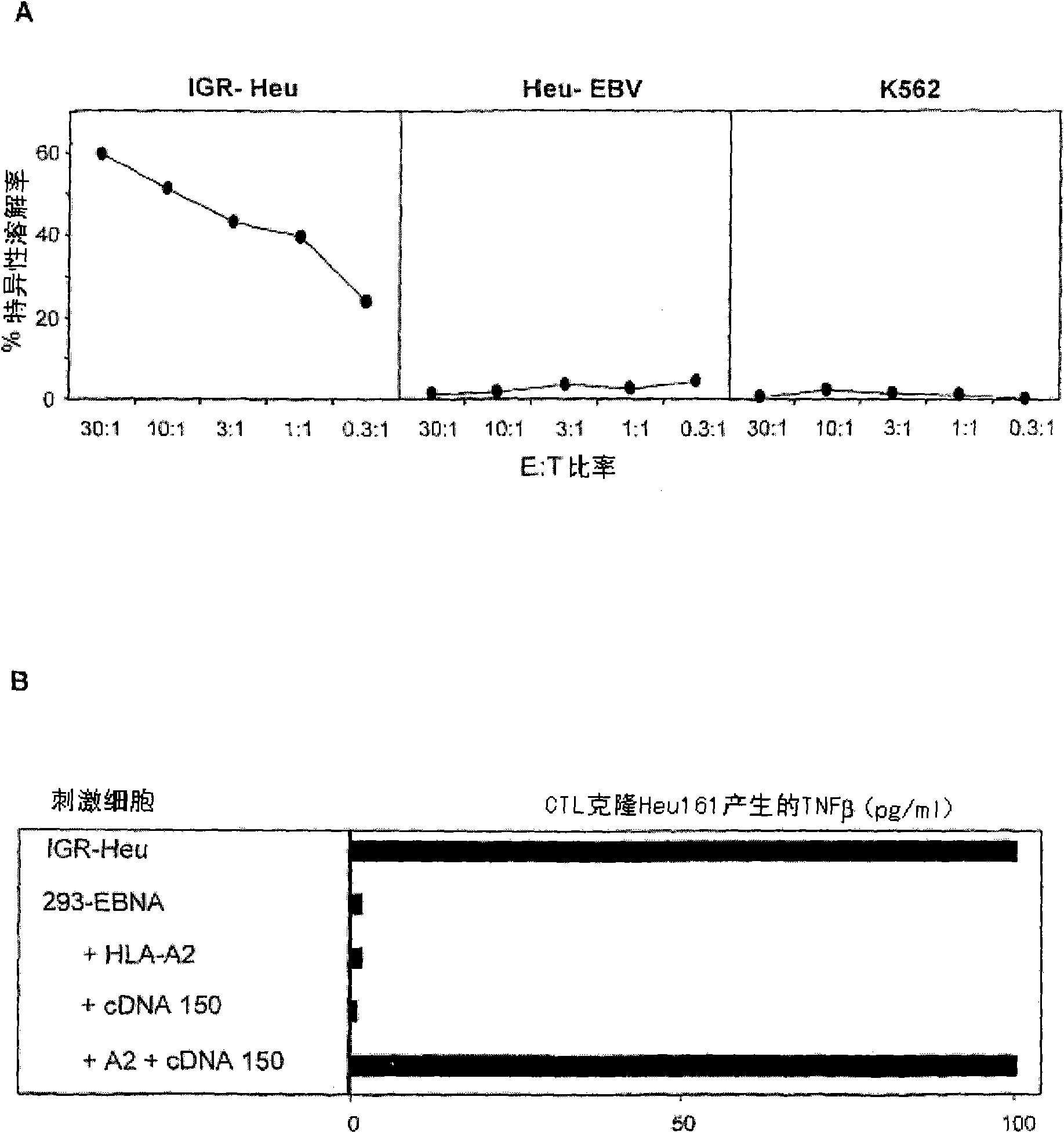Preprocalcitonin antigen T epitopes
An immunogenic, polynucleotide technology, applied in the field of procalcitonin precursor antigen T epitope
- Summary
- Abstract
- Description
- Claims
- Application Information
AI Technical Summary
Problems solved by technology
Method used
Image
Examples
Embodiment 1
[0041] Example 1: Materials and methods
[0042] Derivatives of NSCLC tumor cell lines and autologous CTL clones
[0043] IGR-Heu NSCLC was derived from LCC samples of patients Heu (HLA-A2, A68, B7, B35, C4, C7) as previously reported (ECCHHAKIR et al., Cancer Res, 61, 4078-83, 2001) cell lines and maintained in culture medium. According to the method described in the literature (ECCHHAKIR et al., Int Immunol, 12, 537-46, 2000), the Heu161 clone was derived from autologous TIL, and in a 96-well V-shaped microtiter plate (Nunc, Roskilde, Denmark) Amplify.
[0044] Cytotoxicity assay and TNFβ release
[0045] Cultures were used in triplicate in 96-well plates with round bottoms and passed through common 4-h 51 Cr release assay to measure cytotoxic activity. Percent specific cytotoxicity is usually calculated; SD (standard deviation) + MTC; ECACC, Salisbury, UK) and DMS53 (HLA-A2 - SCLC; ECACC) cell lines were used as targets.
[0046] TNF[beta] was detected by measuri...
Embodiment 2
[0058] Example 2: CTL clones that can recognize autologous lung cancer cells
[0059] Patient Heu(HLA-A2+ ) is a currently disease-free lung cancer patient 11 years after resection of the primary tumor. The LCC cell line IGR-Heu was derived from the patient's resected tumor in 1996. Primary tumor permeable monocytes were isolated and stimulated with irradiated IGR-Heu tumor cells, irradiated autologous EBV-transformed B cells, and IL-2. Responding lymphocytes were cloned by limiting dilution and stimulated with the same mixture of tumor cells and EBV-B cells. Several tumor-specific CTL clones were obtained and differentiated into three groups based on their TCRVβ sequences (ECHCHAKIR et al., Int Immunol, 12, 537-46, 2000). We previously reported that the first two sets of clones (denoted Heu127 and Heu171) recognized antigenic peptides encoded by mutated sequences in the α-actinin-4 (ACTN4) gene (ECHCHAKIR et al., Cancer Res, 61, 4078-83, 2001; ECCHHAKIR et al., Proc Natl A...
Embodiment 3
[0060] Example 3: Identification of genes encoding antigens recognized by HEU161 clones
[0061] Poly(A) + RNA The cDNA library prepared from IGR-Heu cells was cloned into the expression plasmid pCEP4 (ECHCHAKIR et al., Cancer Res, 61, 4078-83, 2001). The library was divided into 264 pools containing approximately 100 recombinant clones, and DNA was prepared from each pool. 293-EBNA cells were co-transfected with DNA from each pool and the HLA-A*0201 construct. After 24h, the CTL clone Heu161 was added to the transfectants; after another 24h, the supernatant was collected, and their TNFβ content was measured with TNF-sensitive WEHI-164c13 cells (ESPEVIK & NISSEN-MEYER, J Immunol Methods, 95, 99-105, 1986). A large proportion (85 / 264) of the cDNA pool proved positive, suggesting that a surprisingly high frequency of about 0.4% of the cDNA clones encoded Ag. One cDNA pool was subcloned, and a cDNA clone called 150 was isolated ( figure 1 B).
[0062] cDNA 150 is 956 bp lon...
PUM
 Login to View More
Login to View More Abstract
Description
Claims
Application Information
 Login to View More
Login to View More - R&D
- Intellectual Property
- Life Sciences
- Materials
- Tech Scout
- Unparalleled Data Quality
- Higher Quality Content
- 60% Fewer Hallucinations
Browse by: Latest US Patents, China's latest patents, Technical Efficacy Thesaurus, Application Domain, Technology Topic, Popular Technical Reports.
© 2025 PatSnap. All rights reserved.Legal|Privacy policy|Modern Slavery Act Transparency Statement|Sitemap|About US| Contact US: help@patsnap.com



